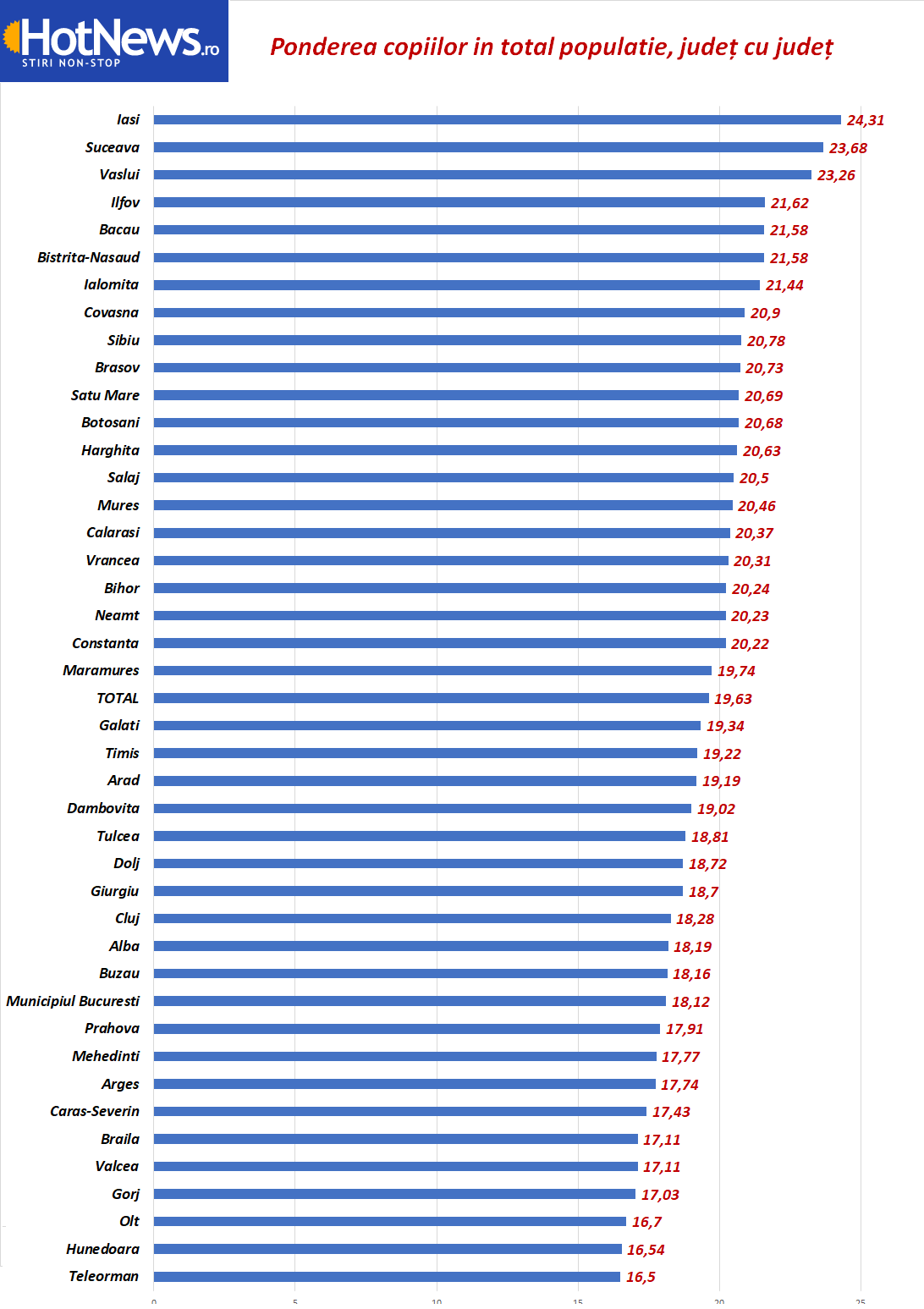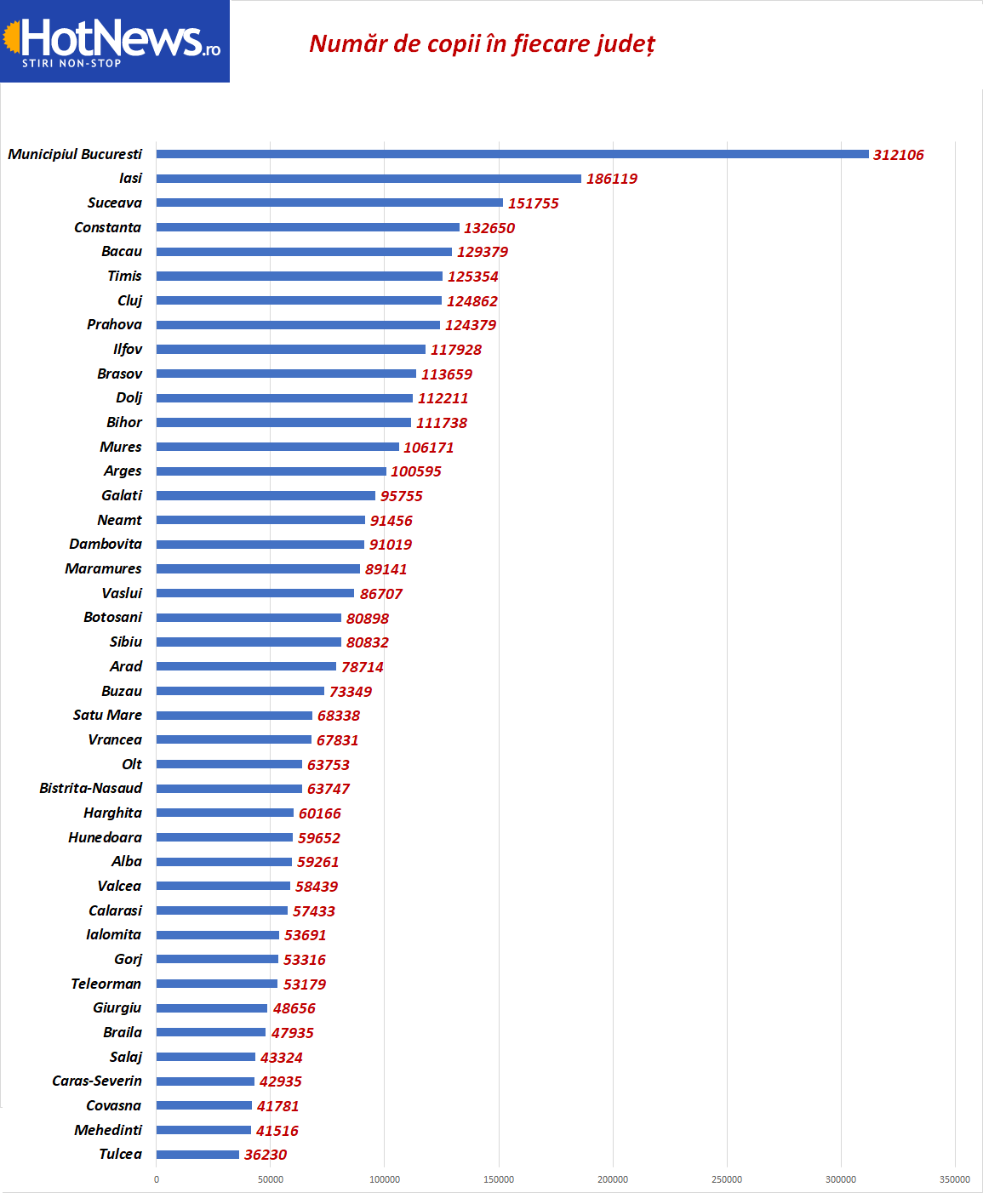
In 2022, more than 25,000 fewer children were born than in 2021, which became a negative record since 1930.
In Karash-Severin, the number of children under 14 decreased by almost 25% between the two censuses (2021 and 2011). From the point of view of the number of educational units and the need for teachers, this is a disaster. Also, the number of school-age children in Olt, Gorzh, Hunedoara and Teleorman decreased by 20%.
Teleorman is the county with the lowest share of children in the total population, almost on a par with Hunedoara and Ault. At the opposite pole are Iasi, Suceava and Vaslui.
Below is a graph of the share of children in the total population of each district:

Below is a graph with the number of children in each district of the country

“The 1961 generation was the last to provide replacement level. All other generations have a final decline below the replacement level,” Professor Vasile Getsau explained at the conference.
1 in 2 children is at risk of serious poverty
According to a study by the organization “Save the Children”, the situation of children in Romania remains marked by serious differences, inequality is present in the lives of Romanian children from birth.
Romania remains at the top of the infant mortality rate, above the EU average, in the last two years maternal mortality has increased dramatically, almost half of the births to mothers under the age of 15 are registered in our country, one of the main reasons for this state of affairs is poverty. If, for example, in 2019, 9.6% of single-parent families were on the poverty line, then in 2020 this percentage doubled to 18.2%, and in 2021 – to 23%.
Overall, almost 1 in 2 children are at risk of becoming poor/socially excluded, leading to school dropout and discrimination.
The risk of poverty or social exclusion is significantly higher in rural areas than in cities: in 2021, the rate was 16.1% in large cities, 30.7% in small cities and suburbs, and 50.1% in rural areas.
In 2021, one in ten families could not afford to adequately heat their home, and almost one in five could not afford nutritious food.
The school dropout rate remained unchanged during the period of application of the Law on National Education No. 1/2011, this phenomenon affected 35,259 students, of which 20,878 were primary and secondary school students and 14,381 high school students (2019/2020 school year).
The phenomenon of non-participation in school in relation to the school population also persists – 286,150 children aged 7 to 17 did not attend school on January 1, 2021, out of a total of approx. 2,500,000 school-age children. In Romania, 15.6% of young people aged 18-24 have completed only eight grades or less, although the target set by Romania in 2010 was to reduce this phenomenon to 11.3% by the end of 2020 year
Public spending on the education of Romanian children is the lowest in the European Union, and parents are forced to cover the shortcomings of the system, amounting to 3.16% in 2019 (against 4.7% on average for the EU-27).
Our country faces a record intensity of educational poverty for children, expressed in poverty (41.5%) and functional illiteracy (43%), but the level of allocation of financial resources remains extremely modest.
Conversely, countries where these problems are by no means the same, responsibly prefer education: Sweden – 7.06%, Belgium – 6.25%, Finland – 6.06%, Cyprus – 5.24%, Poland – 4, 67%, Slovenia – 4.61% or even Bulgaria – 4.20%. The new draft law on pre-university education, which provides for the allocation of 15% of expenditures from the consolidated general budget (which will be slightly more than 4% of GDP) for education, has very little chance of having a tangible effect in the direction of increasing the effective allocation of adequate public resources for the education system, it is also shown in the study “Save the children”.
Source: Hot News
Ashley Bailey is a talented author and journalist known for her writing on trending topics. Currently working at 247 news reel, she brings readers fresh perspectives on current issues. With her well-researched and thought-provoking articles, she captures the zeitgeist and stays ahead of the latest trends. Ashley’s writing is a must-read for anyone interested in staying up-to-date with the latest developments.